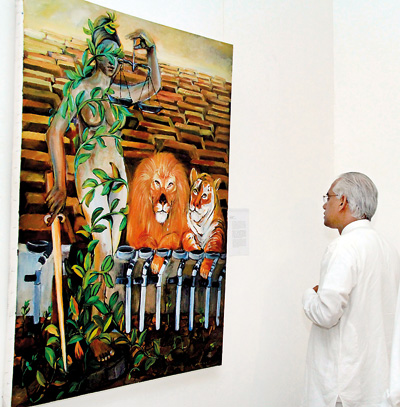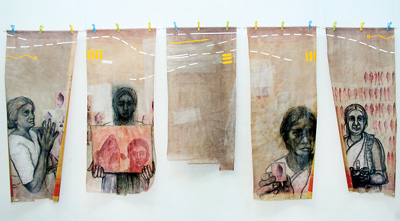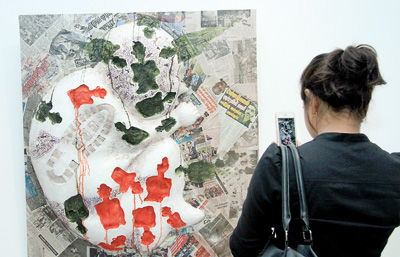Sunday Times 2
When you look at them, you look at us
Hanusha Somasundaram was still in her mother’s womb when their family went to live on a tea estate. Her mother was a tea plucker whose wages were critical to her young family’s survival. Hanusha imagines her, heavily pregnant with twins, labouring on those green slopes. Later, after the births, her mother would leave her children in an estate crèche and go back to work. “How much stress she must have had, how hard she must have had to work because there was not one but two of us,” says Somasundaram now.
 Somasundaram is one of 14 artists to be represented in the ‘Truth to Truth’ exhibition at the JDA Perera Gallery on Horton Place (today, Sunday March 27 is the final day).Her truth is expressed in the form of a delicate series of sketches – the outlines of female tea pluckers traced in black across a carefully pressed collage of tea bags. The women are heavily pregnant, and Somasundaram intended the images to draw attention to exploitative tea industry practices. In places, the pristine white tea bags are dyed brown, so that the curves of the women’s heavy stomachs seem to fall into shadow. The contrast serves to highlight what is seen and unseen, what we choose to celebrate and what inconvenient realities we leave unacknowledged. “The stain on the tea bags represents the stain on society,” says the artist.
Somasundaram is one of 14 artists to be represented in the ‘Truth to Truth’ exhibition at the JDA Perera Gallery on Horton Place (today, Sunday March 27 is the final day).Her truth is expressed in the form of a delicate series of sketches – the outlines of female tea pluckers traced in black across a carefully pressed collage of tea bags. The women are heavily pregnant, and Somasundaram intended the images to draw attention to exploitative tea industry practices. In places, the pristine white tea bags are dyed brown, so that the curves of the women’s heavy stomachs seem to fall into shadow. The contrast serves to highlight what is seen and unseen, what we choose to celebrate and what inconvenient realities we leave unacknowledged. “The stain on the tea bags represents the stain on society,” says the artist.
The workers themselves do not drink the fine tea they gather, instead the dust left over is what they use in their homes. “We work here but our work is enjoyed by others, not us,” says Somasundaram. Her final sketches replace the ordinary women with the figures from the Sigiriya frescoes. “People put so much effort into climbing that mountain to see the frescoes, but our tea pluckers are climbing mountains too. I made the Sigiriya women pregnant as well, and put a basket on their backs, so you will look at them, as you look at us,” said the 27-year-old.
Somasundaram’s name came up again at the panel discussion that kicked off the exhibition on Thursday last week. Artist ChandragupthaThenuwara of the Vibhavi Academy of Fine Arts (VAFA) partnered with the Centre for Policy Alternatives to produce the exhibition. Speaking of the selection process, Thenuwara said that the exhibition was notable for the diversity of voices represented from across the country. “We have people from Ratnatpura, Mattara,Killinochchi, Jaffna, and for the first time someone from the Up Country as well,” he said, adding that artists drew on their personal experiences to create pieces that explored some of the issues their communities grapple with.
The artists first came together in February, Bhavani Fonseka, a Senior Researcher with the Centre for Policy Alternatives told the Sunday Times. “Over the course of a two-day workshop, we discussed what is transitional justice, what is reconciliation and where is Sri Lanka now with the idea that they would capture where we are through their art. They could do anything they wanted to, from displacement to women’s rights within the broad concept of reconciliation.”
For artist Maryathevathas Vijitharan this made sense. To him art is way of communicating emotions and meaning that transcends linguistic and geographical barriers. He points to his paintings – a series titled Bunkers. “If someone looks at this in detail, there is a sense of what I am sharing. This is what I don’t want, I don’t want another war.”
His drawings are dense with bodies and weapons, all seeming to flow across the landscape, in the grip of relentless cross-currents. People are reduced to bodies that crouch and spill over bunkers, simultaneously imprisoned and painfully vulnerable. As civilians attempting to flee areas of conflict during the war, Vijitharan, recalls he and his family sought refuge from the shelling wherever they could find it – under bridges, in canals, even in the shadow of a bicycle. “In some places there was so much sand, and so we couldn’t dig or cut a hole, so we made bundles of our women’s sarees and used those to reinforce the walls,” he says.“I am not going to talk about the government or the Tigers. It is now about the people who live here, the people who survived and we cannot survive another war.”
 Thamotharampillai Shanaathananwho teaches at the Department of Fine Arts at Jaffna University was also a member of the panel. In the context of Sri Lanka’s ongoing engagement with issues of transitional justice, Shanaathanan spoke of how citizens who had lived through the war in the North and East continue to struggle to join the country’s mainstream. Among many there is a need to see what happened to them acknowledged and to have their stories heard. Art, he said, offers a new way to support reconciliation, in a time where the state’s other tools are often perceived as inauthentic or blatantly manipulative. Even more importantly, in this politically charged and emotionally fraught space, art can allow for different kinds of truth.
Thamotharampillai Shanaathananwho teaches at the Department of Fine Arts at Jaffna University was also a member of the panel. In the context of Sri Lanka’s ongoing engagement with issues of transitional justice, Shanaathanan spoke of how citizens who had lived through the war in the North and East continue to struggle to join the country’s mainstream. Among many there is a need to see what happened to them acknowledged and to have their stories heard. Art, he said, offers a new way to support reconciliation, in a time where the state’s other tools are often perceived as inauthentic or blatantly manipulative. Even more importantly, in this politically charged and emotionally fraught space, art can allow for different kinds of truth.
While room was made for multiple perspectives, some of the exhibition’s offerings seemed to be inconsistent in their appeal. (A clear favourite though was Susiman Nirmalavasan’s hauntingly lovely ‘Un throwable questions and Carport Roads’in which the artist asks: Is it a minor issue for a woman to be the head of a household? How many find relief on gazing upon someone’s grave and if weeping resolves grief, how does it happen?)
But where individual pieces sometimes lacked nuance or originality, the exhibition itself represents the kind of civic and artistic engagement we could use more of. The panel, which aside from Thenuwara and Shanaathanan, also featured former President Chandrika Bandaranaike Kumaratunga, had speakers address the audience in Tamil, Sinhala and English, and involved some frank appraisals of the Sri Lanka’s approach to reconciliation and the role art could play in subverting a political system that often failed its people regardless of which party was in power.
 Explaining that it was pulled together in just three weeks, Thenuwara said a key part of the conversation happened between the artists themselves. They grappled with the idea of objectivity and whether to depoliticise their work. “We wait till the government changes and then we try to change the government we voted in, but people say a lot of lies to stay in power,” he said, sharing his belief that civil society and artists were among those who could hold the state accountable. Making the frank admission that “I cannot deviate or distance myself from politics,” he said to his artists: “We used to make art for temples and kings and rich people, now it is time we make art to support the social order.”
Explaining that it was pulled together in just three weeks, Thenuwara said a key part of the conversation happened between the artists themselves. They grappled with the idea of objectivity and whether to depoliticise their work. “We wait till the government changes and then we try to change the government we voted in, but people say a lot of lies to stay in power,” he said, sharing his belief that civil society and artists were among those who could hold the state accountable. Making the frank admission that “I cannot deviate or distance myself from politics,” he said to his artists: “We used to make art for temples and kings and rich people, now it is time we make art to support the social order.”
Featured in the Truth to Truth exhibition are: Markkandu Manokar, Dehigahawatta Gamage Pathum Nimesh, Asanka Manjula, Susiman Nirmalavasan, Pakkiyarajah Pushpakanthan, K.A. Malika Sanjeevani, Nallaiah Savesan, Sarmala Shandrathasan, Hanusha Somasundaram, Krishnapriya Tharmakrishnar, Maryathevathas Vijitharan, NiroshaWanigasuriya, Dimuthu Wanniarachchi, Kalani Menaka Wilson.

